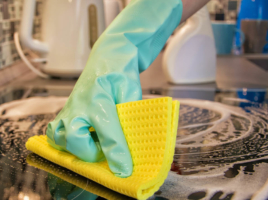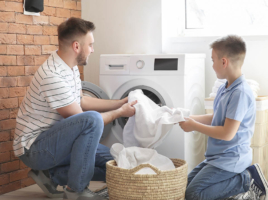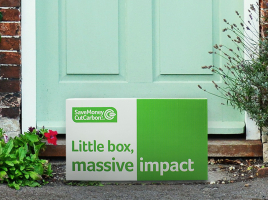Ways to clean your home smarter and greener
Cleaning at home isn’t just necessary, but now a popular trend thanks to the likes of Mrs Hinch and the other many clean-fluencers out there. Not only is it “trendy”, but the pandemic has highlighted the importance of keeping our homes and workspaces germ-free. Especially as we’re now at home a lot more than ever before; the mess makes a difference.
Put these all together and we’re just about ready for a revolutionised way of cleaning!
Being in a clean, tidy home matters more than you think
For whatever reason, spending more time in our home has shifted our cleaning habits. How tidy and clean our home is seems to have an even bigger impact than before – certainly for those of us that are working from home, home-schooling, or simply working in what’s seen as higher risk jobs. As our routines have changed, so have the ways we use the space in our home and the mess we generate at home. If you felt like you were constantly cleaning before the pandemic, I can bet it feels even more so now. Thus, our housework routines have evolved to suit this new reality we seem to be living.
For some, the weekly clean has transformed into daily one-hour blitzes around home-school and working. Breaking up the day has become far more common, showing that little and often is just as effective if not more so.
Another change has been afoot too – there’s a growing importance for products to do the job well while still being environmentally friendly. The pandemic has highlighted how harmful cleaning practices can be to our environment and cleaning more eco consciously is a big part of the shift to living a more sustainable lifestyle.
5 tips to help you start cleaning greener
When you’re at the start of your sustainability journey, it can be really hard to know what to tackle first. Here are some easy ways to start adjusting your cleaning routine to be eco-friendlier and more ethical.
Do your research
To make sustainable choices it’s important to be informed. Don’t accept greenwashed claims of some brands at face value – if you have a favourite brand, look up their sustainability credentials. How transparent are they about their packaging? Do they list where they source their ingredients? Are they working with an environmental charity, or implementing ways to reduce their carbon footprint? Or is it not clear, and all you can find are unsubstantiated “green” claims?
This will make it easier for you to decide what’s important to you when shopping for sustainable products.
Check ingredients
Familiarise yourself with the ingredients that don’t just irritate the skin but have an environmental impact too.
The problem with the harmful chemicals in cleaning products is that they are toxic and degrading to animal and human health as well as the environment. When washed down the drain and sent to water treatment plants, not all the contaminants are removed. These make their way to our rivers and lakes, harming marine and aquatic life. Preservatives such as parabens and triclosan can be irritating, while triclosan is also thought to cause adverse effects in the aquatic environment.
Additionally, they contain VOCs (Volatile Organic Compounds) that can also be degrading to the already depleting ozone levels, becoming a factor for climate change. However, they can also cause lung irritation and affect people with allergies like asthma. Another problematic ingredient is palm oil, which is a driver for deforestation, so it’s better to look for more sustainably sourced alternatives.
To avoid harsh chemicals, make sure you’re choosing products with allergy-free or organic certification credentials. You should also look for vegan-friendly and cruelty-free products, as they don’t contain animal products (like animal fat in detergent, yuck!) and are not tested on animals.
Reduce plastic waste
Many of our household products are made with plastic – trigger sprays, sponges, scourers, dish brushes. The list could go on.
Plastic is a very unsustainable material to use for these kinds of items – for example, sponges break down with regular use, releasing tiny particles of polyurethane called microplastics down the drain. Some of these are so small, they manage to make it out into the natural environment, harming wildlife.
There are so many sustainable swaps for your trusty cleaning products and tools, that live either in your utility room or in your kitchen. To name a few:
- Biodegradable or compostable bin liners
- Wooden, natural scrubbing brushes
- Compostable sponges
- Bamboo towels
- Natural scourers and bottle brushes – or galvanised steel scourers
- Cleaning EcoDrops
- Refill liquid soaps or solid dish soaps
- Recycled rubber gloves
- Reusable Laundry Egg and Dryer Eggs
Many cleaning products come in plastic bottles – but there are many refillable concentrated cleaners you can dissolve in water, so make sure you keep your old plastic bottles for reuse. Similarly, try and choose products who’s packaging is sustainable too – for example, ecoegg use FSC certified, recyclable packaging with vegetable-based inks.
Consider energy usage
Our energy usage will contribute to your carbon footprint – making sure that you’re smart with your energy usage is another important aspect.
Make sure your appliances are energy efficient (but don’t go chucking out your perfectly functioning dishwasher if it isn’t!) and make use of the eco settings. For example, I’ve found that my eco setting on my washing machine cleans my laundry perfectly every time, and if I’m washing something that needs a higher temperature to kill germs, I can still make use of it by just adjusting the temperature.
Same with your dishwasher – your eco setting will clean those dishes just fine, without overspending energy and water. There are also other tools you can use, like ecoegg dryer eggs to reduce tumble drying time by 28%; running full loads of dishes and washing; using a dustpan and brush for crumbs, rather than a vacuum.
Get fresh air circulating
Indoor air pollution is over three times worse than outdoor air pollution in the UK – from VOCs and more. This is due to a combination of indoor activities like cooking, burning wood and cleaning, which creates a build-up of pollution inside the home. This build-up takes longer to disperse than pollution outdoors.
Opening your windows for even a short time period each day will help allow fresh air to circulate – this is especially important to do when you’re cleaning.
If you’re having trouble with odours, particularly in the fridge or soft furnishings like rugs and carpets, bicarbonate of soda is great at eliminating these unwanted scents. Filling your home with plants will also work to filter the air.
7 tips to clean your home a smarter way
These 7 golden rule will help you clean your house top to bottom in the most efficient way – giving you more time for the stuff that really matters!
Rule 1: Start by working from top to bottom
Make sure you start in corners, light fixtures, shelving, mirrors, picture frames and curtains. This way the dust falls downwards first, so you don’t then get a clean floor dirty. Shake your curtains gently and pop them in the tumble dryer for 10 mins – this will help loosen the hair and dust particles! Make sure to check the label before chucking in the tumble dryer though.
Then, wipe any surfaces at waist height or below: end tables, TV units, corner units and so on so that any dust or long forgotten biscuit crumbs get pushed onto the floor. When you get to the floor, whether sweeping, mopping or vacuuming, make sure you start from the point furthest from the door. This way, you won’t box yourself in.
Rule 2: Prioritise the order of your rooms
Rooms or spaces with a heavy footfall in your home are going to get dirtier much quicker, especially when you add kids and pets into the mix. By keeping hallways, stairs and landings regularly swept, mopped or vacuumed can prevent unwanted grime being walked further into the house.
Then, prioritise the rest of the rooms in your home by order of “traffic” – you could even do the lounge last so that when you’re done, you can put your feet up straight away!
Rule 3: Separate wet tasks from dry ones
When you’re strapped for time, the dry cloth jobs are the easiest to get done with the least faffing about. This includes dusty surfaces, TV and computer screens (and anywhere dust clings around wires), photo frames and lampshades. If the dust on shades is a bit stubborn, a good trick is getting the hairdryer on it.
Next, do any jobs you can get done with a spray and cloth – and go on a hunt for any surfaces that need wiping down as opposed to dusting.
Then when you’re ready, you can get all your buckets, brushes and gloves out for the wetter tasks.
Rule 4: Be organised before you start
Two words: colour coordination. Try and split your cloths across different rooms, or areas within that room to avoid cross-contamination. My trusty “pink for the sink and blue for the loo” rhyme is really handy to remind me which cloth I used for where. If you don’t have coloured cloths, you could try dyeing them naturally with beetroot, tea, turmeric, blueberries and all sorts of other waste produce.
Try multipurpose cleaners that work across different surfaces too, to reduce the products you are lugging around the house, or stored in your cupboard.
A cleaning caddy or basket you can carry from room to room really helps avoid piles of forgotten, empty bottles, aerosols and empty loo roll from lurking cabinets, under sink cupboards or corners. Oh, and also to carry your tools around with you!
Rule 5: Wave goodbye to grease
Invest in some reusable oven liners and reusable baking paper, you know you want to. These are super easy to pop into your oven, they catch any grease or food overflows. Instead of getting down on your hands and knees (for those of you who are, like me, unlucky enough to have a standard floor-based oven!) you can just scrape chunks into the bin, and wash the liner in the sink.
Alternatively, opt for recycled tin foil – make sure to give it a wash so it can be properly recycled and hopefully made into more tin foil!
You should also steam the microwave regularly after using to stop a build-up of greasy muck. Add a few drops of white vinegar or lemon juice to a water-filled microwaveable bowl and heat for 2-3 minutes. Remember it’ll be hot so use oven gloves to remove the bowl, then wipe clean with a cloth.
Rule 6: Catch spills to save time later
Do you go to change the bin bag, or fill the fridge with the next weekly shop and are greeted with a leaky mess?
Either invest in fridge liners or line the bottom of drawers in your fridge with a tea towel or bamboo towel. Then, all the crumbs of broccoli, bits of stray onion skin or squishy tomato juice will be caught by it – simply take it out carefully, shake it into the bin and pop in the wash!
With your bin, you could do a similar technique or lay a sheet of old newspaper on the bottom of your bins and then put in a new bin liner, making it easier to quickly wipe up any liquid spills.
Rule 7: Not all laundry is equal
As we are all much more mindful of spreading germs, it’s good to note that not all items of laundry need the same treatment in the washing machine. Some are higher risk need to be washed at 60°C.
These include: bath or shower towels; facial cloths; cloths used in food prep; the clothing worn over a wound or infected skin; health care workers’ uniforms, clothing of an infected person, anything soiled in vomit or faeces like reusable nappies – and your underwear.



